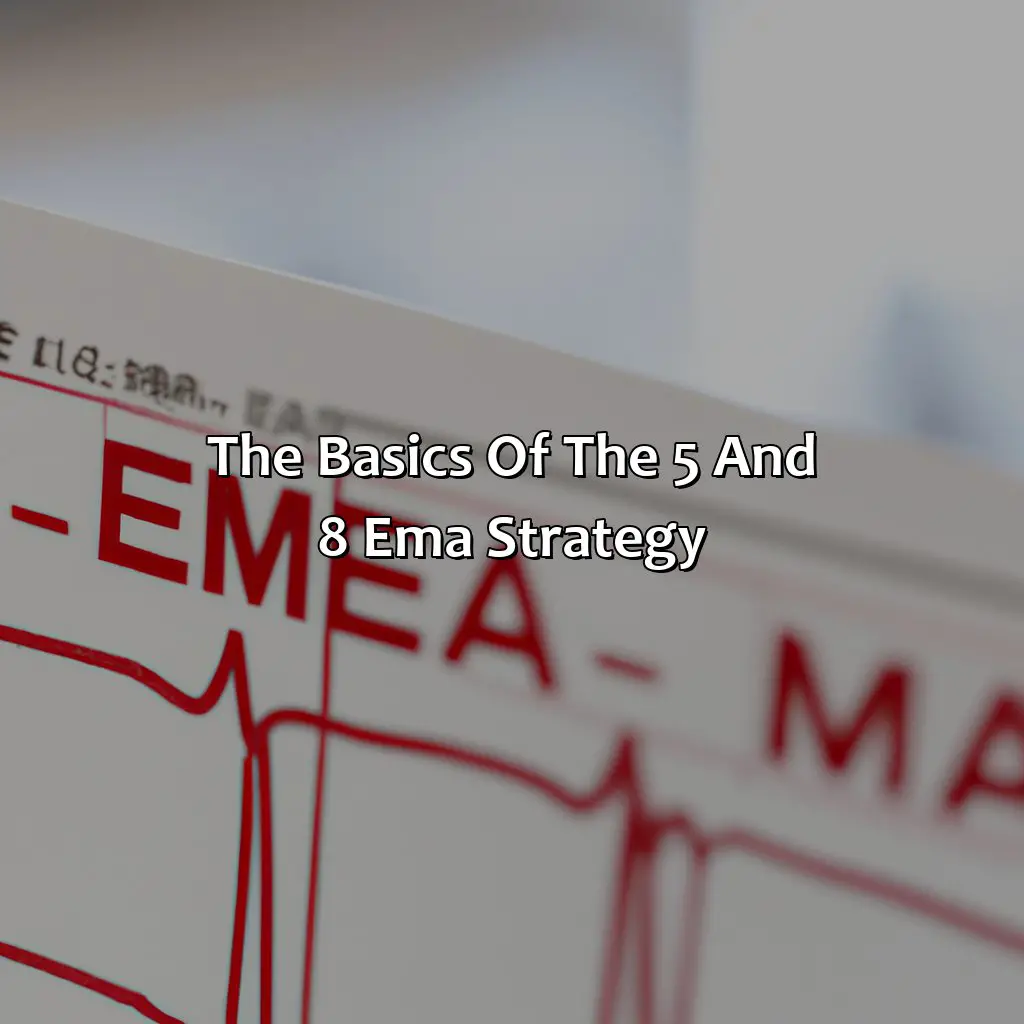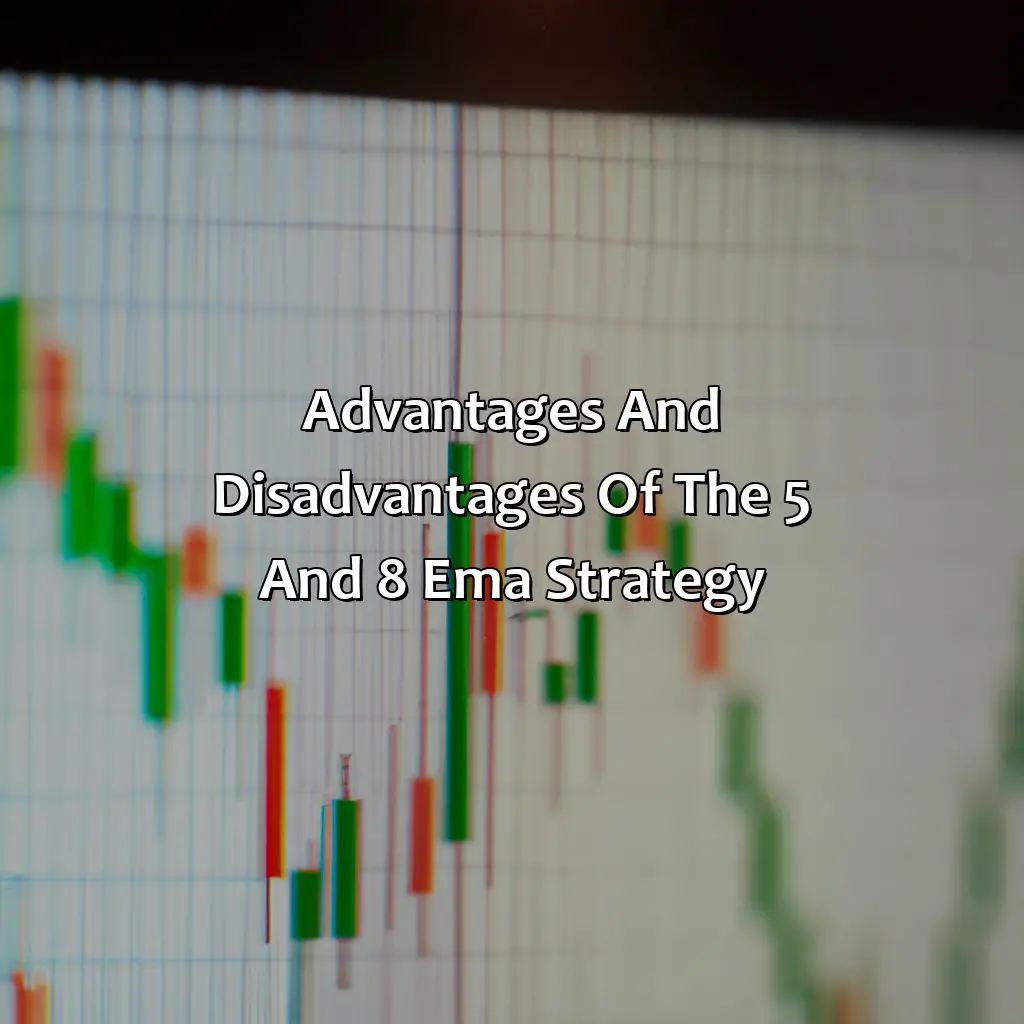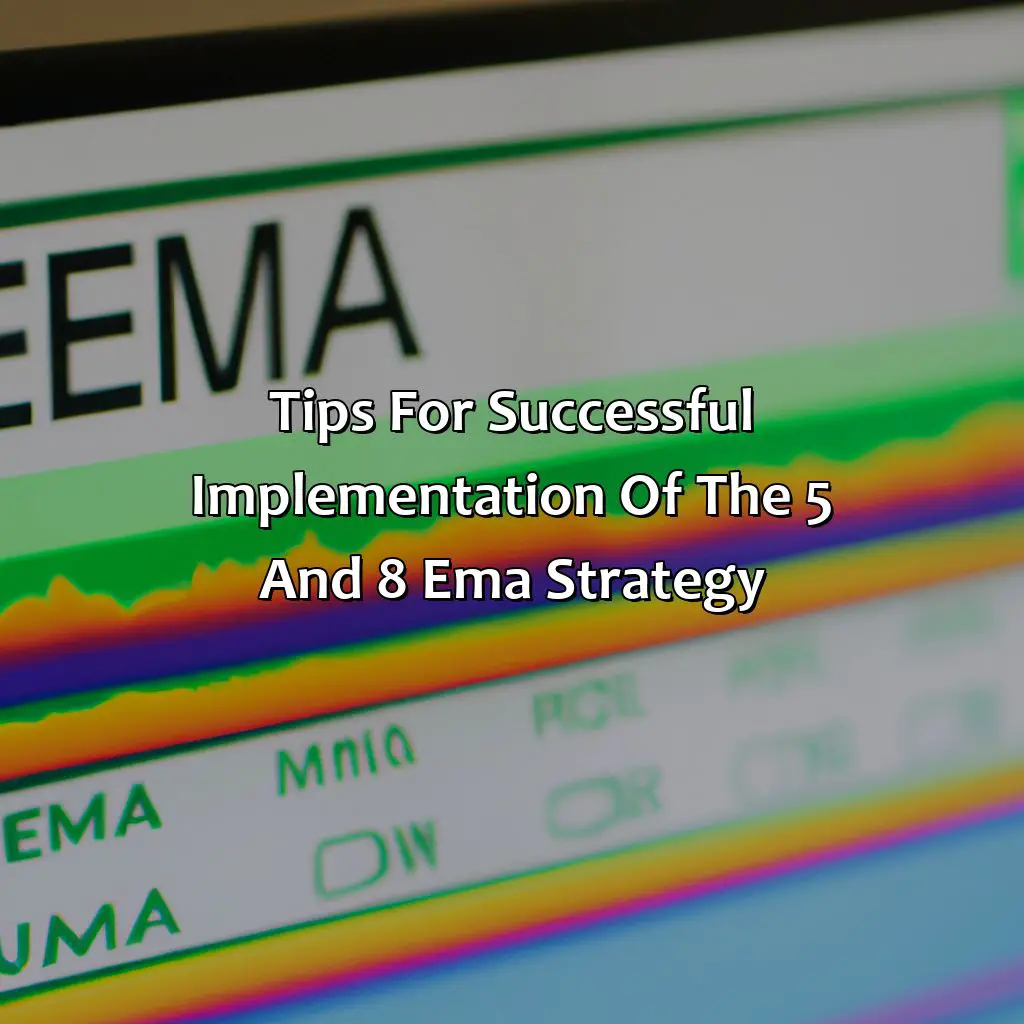
##Key Takeaway:
Key Takeaway:
- The 5 and 8 EMA strategy is a popular trading strategy used in stock trading and technical analysis. It involves using two exponential moving averages – the 5 EMA and the 8 EMA – to identify trends and make trade decisions.
- The strategy is simple and easy to use, making it suitable for both beginner and experienced traders. It involves identifying trends and momentum signals using charting software, and then entering and exiting trades based on these signals.
- The key to success with the 5 and 8 EMA strategy is maintaining discipline and patience, adapting the strategy to your trading style, and using stop loss orders to limit risk. By carefully managing risk and staying informed about market trends and insights, traders can improve their chances of success with this strategy.
The Basics of the 5 and 8 EMA Strategy

Photo Credits: forexbrokerreport.com by Randy Walker
To learn the 5 and 8 EMA strategy, we’ve outlined three sections.
- Firstly, we’ll explain EMAs and what exponential and moving averages are.
- Then, we’ll provide steps on how to calculate EMAs and why charting software is needed.
- Lastly, we’ll explain what the 5 and 8 EMA strategy means in stock market trading.
Explanation of EMAs
EMAs, short for exponential moving averages, are technical analysis tools that help traders identify trends in financial markets. They are a type of moving average that emphasizes recent price changes over older ones by giving more weight to current data. This makes them more responsive to short-term price movements and less subject to lag compared to other types of moving averages like simple moving averages (SMAs). EMAs have become increasingly popular in recent years due to the increased use of algorithmic trading and technical analysis. Like SMAs, they are useful in identifying support and resistance levels as well as potential buy and sell signals.
Calculating EMAs is easier than convincing your grandma to switch from AOL to Gmail.
How to Calculate EMAs
Exponential Moving Averages (EMAs) are essential charting tools for traders and investors. To calculate EMAs, you need to take into account a time series of asset prices and assigning greater weight to most recent data points.
- Choose your time period – Decide on the number of periods you want to use for the calculation, which ranges between 5-200.
- Calculate initial Simple Moving Average (SMA) – Add up the closing prices from each period and divide by your number of periods.
- Calculate Multiplier (M) – Multiply by your smoothing factor, which increases for more recent data points. The calculation is usually 2 / (number of periods + 1).
- Calculate the EMA value – Multiply today’s price with M and yesterday’s EMA value. Then add this result to yesterday’s close, multiplied by (1-M).
- Continue this process – Repeat step 4 daily using the last day’s EMA until you run out of data points in your time series.
It is important to note that many charting software packages automatically calculate EMAs using different time intervals. Additionally, trailing EMAs offer different signals about price trends than simple moving averages.
A crucial aspect while calculating EMAs is to choose an appropriate smoothing factor that suits one’s trading style and objectives.
The 5 and 8 EMA strategy: the perfect marriage of simplicity and effectiveness in the stock market.
What the 5 and 8 EMA Strategy Means
The strategy of combining 5 and 8 Exponential Moving Averages (EMA) is a popular trading strategy in the stock market. The strategy is based on short-term trends and uses the 5-EMA and 8-EMA as indicators for traders to identify entry and exit points in a trade.
- The 5 EMA Strategy is an indicator that shows whether there’s a long-term trend. It provides signals to traders when the price breaks out from the bullish or bearish trend, which can be used to create buy or sell positions.
- On the other hand, the 8 EMA Strategy is an algorithm that follows market trends shorter than those considered by the 5 EMA. This fast-moving signal gives traders information about shorter-term movements that are often missed by longer-term instruments such as the 5 EMA.
- Using both the 5 EMA and 8 EMA strategies together helps traders to interpret medium and short-term signals while considering both factors simultaneously, making it easier to determine the best trading decisions.
Some unique details that have not been covered already include that using this strategy can help prevent traders from reacting impulsively to small fluctuations. Instead, they can stick with their pre-determined rules of engagement according to this trading methodology.
A well-known trader named Linda Raschke reportedly used this technique in her analysis which led her profit levels soaring by large margins. Using this exact method requires discipline and patience.
A true story involves a trader who tried numerous strategies but could not manage profitable trades until he stumbled upon the benefits of using these two simple moving averages together. Following meticulous tracking over months of data, he noticed an improvement in his profitability levels daily. Today he adopts it as his go-to-trading strategy.
Follow the trend and analyze price movements with the 5 and 8 EMA strategy to identify buy and sell signals for effective momentum and swing trading.
How to Use the 5 and 8 EMA Strategy

Photo Credits: forexbrokerreport.com by David Walker
Identify trends in price movement with the 5 and 8 EMAs to use the strategy for trend following. Estimate bullish and bearish trends with chart analysis. Enter trades using buy and sell signals with help from charting software. Exit trades strategically with signals derived from the 5 and 8 EMAs, plus charting software and support and resistance.
Identifying Trends with the 5 and 8 EMAs
Identifying Market Trends with the 5 and 8 EMAs
A vital part of successful trend following strategy is identifying market trends. The 5 and 8 EMA trading system helps determine both bullish and bearish trends using two exponential moving averages. Here are the six steps to using the 5 and 8 EMA trading system to identify market trends:
- Set up your charting software and select a timeframe.
- Add both 5-EMA and 8-EMA indicators to your price chart.
- Observe the angle between the two EMAs, which indicate the strength of the trend.
- If the 5-EMA is moving above the slower-moving 8-EMA, it is indicative of a bullish trend.
- On the other hand, if the faster-moving EMA falls beneath, a longer-term moving average a downtrend may be imminent.
- Continue to monitor price action on your selected timeframe.
While monitoring trading positions using this strategy, traders must also focus on candlestick signals from their charts to confirm potential changes in price direction estimation.
To successfully implement this strategy, utilize reliable charting software for accurate trend analysis; another important tip includes considering how far away stop-loss orders should be placed based on risk tolerance levels. Don’t miss out on optimal trading opportunities; adapt your TA strategies to market conditions by continually analyzing price charts with diligent practice and patience for fruitful results in your investment portfolio.
Get ready to hit that ‘buy’ or ‘sell’ button with these trading signals from the 5 and 8 EMAs, charting software not included.
Entering Trades with the 5 and 8 EMAs
The 5 and 8 EMA strategy provides trading signals based on the intersection of two exponential moving averages. To enter trades with this strategy, traders must wait for a specific signal to buy or sell that is indicated by the crossover of these EMAs.
- Use charting software to monitor the trends of an asset.
- When the price moves up, wait until the 5 EMA crosses above the 8 EMA. This crossing indicates a buy signal.
- When the price moves down, wait until the 5 EMA crosses below the 8 EMA. This crossing indicates a sell signal.
- Enter trades accordingly based on these signals.
It’s important to note that support and resistance levels can have an impact on when and where these trade signals occur. As such, it’s essential to also take into account other technical analysis tools and market conditions when using this strategy.
With its simple approach, the 5 and 8 EMA strategy has gained popularity among traders who put emphasis on moving averages while considering buying and selling assets. However, it may not work well in all market conditions, such as during periods of high volatility or low liquidity. Therefore, it’s crucial to also evaluate its effectiveness over time before making major decisions in trading.
As an example of its effectiveness or lack thereof consider Linda Bradford Raschke who is amongst industry experts who use such strategies day in day out with positive results. On the contrary, an anonymous Reddit user shared losses following advice from peers to rely solely on the strategy without considering more factors leading to losses being incurred repeatedly.
Exiting trades with the 5 and 8 EMAs is like getting a reliable GPS signal; it’s all about charting your course with precision and knowing when to hit the road.
Exiting Trades with the 5 and 8 EMAs
To exit trades using the 5 and 8 EMAs, traders must look for trading signals indicating a potential trend reversal. The strategy aims to take advantage of short-term price movements while minimizing risk by exiting trades when prices begin to show signs of reversing.
As the EMA lines cross each other, traders can look for buy or sell signals depending on the direction of the crossover. In addition, traders should assess support and resistance levels in the market to further confirm their entry or exit positions.
When an asset’s price breaks through a significant support or resistance level, it may be time to exit a trade. Charting software can help traders identify these levels with greater accuracy and confidence.
Finally, having stop-loss orders in place is essential when executing this strategy since taking losses is an inherent part of trading. By limiting potential losses, traders can focus on taking advantage of profitable opportunities without exposing themselves too much.
According to Investopedia, “The 5- and 8-day moving averages are generally used to generate buy/sell signals based on crossovers with the longer-term average.”
Trade your way to success with the 5 and 8 EMA strategy, but be mindful of the psychological pitfalls and risks of trading.
Advantages and Disadvantages of the 5 and 8 EMA Strategy

Photo Credits: forexbrokerreport.com by Walter Martin
Know the advantages and downsides of the 5 and 8 EMA strategy. Let’s explore its pluses and minuses. Find out the pros, such as it works for short and long-term trading, stock trading, and how to manage risk by backtesting and position sizing. Learn the cons, like its effect on your trading psychology, trading plan, and risk/reward ratio.
Benefits of the 5 and 8 EMA Strategy
The 5 and 8 EMA strategy offers several advantages for stock trading.
- Improved trend identification: The strategy provides a clear indication of the current trend, which is essential for successful stock trading.
- Simple and easy to use: The 5 and 8 EMA strategy only requires basic calculations and a few simple rules to implement, making it accessible even to novice traders.
- Effective in both short-term and long-term trading: This strategy can be used for various durations of trades, from short term to long term.
- Backtesting proven: The 5 and 8 EMA strategy has been tested over various historical data sets, and the results have been consistent, thus enhancing its effectiveness.
- Efficient risk management: The strategy allows traders to manage risks by using stop loss orders to limit losses.
To make this strategy work effectively, some tips must be kept in mind.
- Discipline and Patience: Consistency breeds success in trading; therefore, having discipline in adhering to the rules of the strategy is necessary. And patience is required as sometimes trades may not go as planned.
- Adaptation: Different traders have different personalities or styles; hence such traders should adapt the rules of this strategy to their style because what works for one trader might not necessarily work for another trader.
- Risk Management through Stop Loss Orders: Position sizing plays an important role in risk management while stop loss orders allow traders maximum protection on any trade they enter into so that possible negative trades can be limited.
Overall, incorporating the 5 and 8 EMA strategy alongside proper risk management methods like position sizing makes it an excellent tool for potential profit-maximizing stock market investments. When it comes to the 5 and 8 EMA strategy, a poor trading plan and risky mentality could leave you with a risk/reward ratio as unbalanced as a clown on a unicycle.
Risks of the 5 and 8 EMA Strategy
The potential downsides of implementing the 5 and 8 EMA strategy must be considered before utilizing it in trading. This will help to avoid unfavorable outcomes and prevent damage to a trader’s portfolio.
- False Signals: One of the principal risks involved in this strategy is that it can produce false signals, which may lead to wrong trading decisions. Market conditions such as high volatility, wild price action, or news release events may affect the accuracy of EMAs.
- Whipsaws: Occasionally, cross-overs between EMAs occur too frequently, producing quick changes in market direction. These whipsaws may result in losing trades.
- Limits Cross-Timeframe Analysis: The shorter-term focus provided by this strategy might limit cross-timeframe analysis opportunities. Failure to do so could make traders miss market patterns, leading to lower profits or losses.
- Overconfidence: Overconfidence resulting from strictly following rules and not researching other factors affecting the market could cause traders to make hasty or long-term decisions which do not align with their trading plan.
- Poor Trading Psychology: Failing to follow a trading plan without discipline or patience can lead to losses due to impulsive decisions caused by emotions rather than strategic judgment.
It is wise for traders hoping to implement this strategy successfully to understand these risks fully and develop effective methods for managing them. Traders can minimize these risks by sticking with their trading plans while considering different market factors that may impact trades.
To mitigate risks associated with EMA crossovers, traders should employ sensible risk/reward ratios when entering trades and maintain good trading psychology by using stop-loss orders. Additionally, they should continually test their strategies through trial and error until they are confident enough about consistent outcomes when using this approach. Finally, adapting the strategy based on individual preferences and styles is also key for optimizing success.
Successful implementation of the 5 and 8 EMA strategy requires discipline, adaptability, and staying informed about market trends through trading forums, mentorship, and performance analysis.
Tips for Successful Implementation of the 5 and 8 EMA Strategy

Photo Credits: forexbrokerreport.com by Joshua Nelson
For successful 5 and 8 EMA strategy implementation in trading, discipline and patience are essential. Adapting the strategy to your trading style and utilizing stop loss orders is also significant. This section with keywords such as trading education, investing education and trading community, will help you implement this strategy well.
The sub-sections, ‘Disciplined and Patient Trading’, ‘Trading Style’, and ‘Risk Management’ will provide valuable insights for your market forecasting and performance analysis.
Maintain Discipline and Patience
Disciplined and patient trading psychology is essential when implementing the 5 and 8 EMA strategy. Consistency in following the rules of the strategy is crucial to reap its benefits. Traders should avoid impulsively entering and exiting trades based on emotions or gut feelings.
To maintain discipline and patience, traders must first develop a clear understanding of their trading goals and limit orders. They should stick to their predetermined rules for entering and exiting trades, without getting swayed by market fluctuations or sudden changes in prices.
Traders can further maintain discipline by keeping a trading journal to track their progress, analyze their decisions, and learn from mistakes. It also helps them stay accountable for their actions and keep emotions in check.
In terms of patient trading, traders should not rush into taking positions but instead wait for appropriate market conditions that align with their trading plan. They should avoid overtrading and take breaks whenever necessary to avoid burnout.
By maintaining discipline and patience, traders can increase their chances of success with the 5 and 8 EMA strategy while enhancing their overall trading skills.
Adapting the 5 and 8 EMA strategy to your trading style: because successful traders don’t force a square peg into a round hole.
Adapt the Strategy to Your Trading Style
To effectively utilize the 5 and 8 EMA Strategy, it is essential to adapt the strategy to your unique trading style. Each trader has their own methods based on factors such as personal preference and risk appetite. Therefore, it is crucial to adjust your trading plan to fit in with this strategy.
One efficient way of adapting the strategy is by performing backtesting with a demo account. This testing will provide insights into how the 5 and 8 EMA Strategy performs when used in your trading style’s context. You can then identify possible areas of adjustment and make appropriate alterations accordingly.
Additionally, understanding your time frame preferences can have an impact on adjusting this strategy. If you prefer trading long-term trends, then utilizing weekly charts may be more effective for you than daily ones.
To fully optimize the advantages of adaptation, ensure that your adjustments align with your overall trading plan. Remember that applying a strategy based solely on its reputation without considering one’s personal preferences can lead to ineffective trades.
It is often advisable to consult a professional when making crucial decisions about adapting the 5 and 8 EMA Strategy or any other strategy for that matter.
Adapting strategies according to unique styles isn’t new; traders have been doing it for years. Day traders frequently use scalping strategies while swing traders focus on catching market swings over multiple days instead of hours or minutes.
Stop loss orders are like a bouncer for your trading account, kicking out the risk before it becomes a problem.
Use Stop Loss Orders to Limit Risk
One of the fundamental principles of risk management in trading is the use of stop loss orders to limit potential losses. By placing a stop loss order, you can specify an automatic sell order for your position at a predetermined price level. This helps traders manage their risk exposure and prevent large losses in case a trade goes against their expectations.
Here’s a simple guide on how to use stop loss orders to limit risks in trading:
- Determine your risk tolerance and set your maximum acceptable loss for each trade.
- Identify key support and resistance levels on your chart, which can serve as potential stop loss levels.
- Set your stop loss order at or below the identified support level for long positions and above the resistance level for short positions.
- Monitor your trades closely and adjust your stops as needed based on price action movement or changes in market conditions.
- Remember that using stop loss orders is not foolproof and no guarantee that you will always avoid losses. You should still exercise caution and follow proper risk management practices.
It’s essential to note that using stop-loss orders may lead to slippage (the difference between the desired sell price and actual execution price) during periods of high volatility, gaps, or sudden market moves. As such, utilizing other techniques such as position sizing can help reduce potential losses.
In addition to using stop-loss orders, traders should consider diversifying their portfolios across different asset classes or markets, maintaining adequate liquidity when trading volatile instruments, and keeping track of news events that could affect the markets.
By adhering to these guidelines for risk management, with particular attention paid towards utilizing stop-loss orders appropriately, traders can minimize their exposure to significant losses while still participating in potentially profitable trades.
Some Facts About the 5 and 8 EMA Strategy:
- ✅ The 5 and 8 EMA strategy is a technical analysis tool used to identify trends in the market. (Source: Investopedia)
- ✅ It involves using two exponential moving averages, the 5-day EMA and the 8-day EMA, to track price movements. (Source: Trading Strategy Guides)
- ✅ The 5 and 8 EMA strategy can be used for both short-term and long-term trades. (Source: StockTrader.com)
- ✅ It is important to practice risk management and have a clear exit strategy when using the 5 and 8 EMA strategy. (Source: My Trading Skills)
- ✅ The effectiveness of the 5 and 8 EMA strategy depends on various market factors and should be used in combination with other technical indicators for best results. (Source: The Balance)
FAQs about What Is The 5 And 8 Ema Strategy?
What is the 5 and 8 EMA strategy?
The 5 and 8 EMA (Exponential Moving Average) strategy is a trading strategy that helps traders spot trends and trade in the direction of the trend. It involves using two moving averages, the 5 EMA and the 8 EMA, to identify trend direction and generate buy and sell signals.
What is the difference between trending markets and non-trending markets?
Trending markets are characterized by consistent and directional movements in price, while non-trending markets are those with little to no directional movement. In trending markets, the 5 and 8 EMA strategy can be very effective, whereas in non-trending markets, the strategy may generate false signals.
What are the buying and selling rules for the 5 and 8 EMA strategy?
The buying rule for the 5 and 8 EMA strategy is to buy when the 5 EMA crosses above the 8 EMA and both EMAs are sloping upwards. The selling rule is to sell when the 5 EMA crosses below the 8 EMA and both EMAs are sloping downwards.
What is a trailing stop and how is it used in the 5 and 8 EMA strategy?
A trailing stop is a dynamic stop-loss order that is placed above or below the market price depending on the direction of the trade. In the 5 and 8 EMA strategy, a trailing stop can be used to lock in profits as the trend continues, by adjusting the stop-loss order to follow the price at a fixed distance.
Is the 5 and 8 EMA strategy suitable for beginners?
The 5 and 8 EMA strategy can be suitable for beginners as it is relatively easy to understand and implement. However, like any trading strategy, it requires discipline and risk management.
Can the 5 and 8 EMA strategy be used on all markets, such as stocks and commodities?
Yes, the 5 and 8 EMA strategy can be used on various markets, including stocks and commodities, as long as there is a strong trending market. However, traders should also consider other factors such as liquidity and volatility when choosing which markets to trade.


